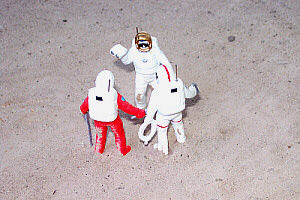The Moon
 Earth’s large natural satellite is home to dozens of settlements ranging in size from small mining camps to bustling cities such as Landsberg and Heinlein. The plethora of settlements should come as no surprise, since the Moon is only 238,000 miles away and even low Isp chemical rockets can make the trip in just a few days. The Moon’s close proximity to Earth and abundant raw materials make it ideal for colonization despite seemingly harsh conditions. The low gravity (apx. 1/6G) is actually a plus, since it allows large structures to be lightly constructed and easily handled. Additionally, the Moon’s lack of an atmosphere means that structures do not have to be able to withstand the effects of wind and weather, although habitats are usually buried underground for protection against meteors and insulation against surface temperature extremes. Most of the materials needed for a self-sustaining colony are locked within the lunar regolith. Utilizing readily available unfiltered sunlight to produce energy, the lunar soil can be "cracked" to yield aluminum, iron, oxygen, silicon, titanium, etc. Prospectors have also discovered deposits of gold, silver, uranium and other precious metals in the lunar mountains. Even water in the form of ice may be found in the perpetual shade of deep craters. Terrestrial food crops grow well in lunar soil provided they’re enclosed in a pressurized bubble, generously fertilized, and watered.
Earth’s large natural satellite is home to dozens of settlements ranging in size from small mining camps to bustling cities such as Landsberg and Heinlein. The plethora of settlements should come as no surprise, since the Moon is only 238,000 miles away and even low Isp chemical rockets can make the trip in just a few days. The Moon’s close proximity to Earth and abundant raw materials make it ideal for colonization despite seemingly harsh conditions. The low gravity (apx. 1/6G) is actually a plus, since it allows large structures to be lightly constructed and easily handled. Additionally, the Moon’s lack of an atmosphere means that structures do not have to be able to withstand the effects of wind and weather, although habitats are usually buried underground for protection against meteors and insulation against surface temperature extremes. Most of the materials needed for a self-sustaining colony are locked within the lunar regolith. Utilizing readily available unfiltered sunlight to produce energy, the lunar soil can be "cracked" to yield aluminum, iron, oxygen, silicon, titanium, etc. Prospectors have also discovered deposits of gold, silver, uranium and other precious metals in the lunar mountains. Even water in the form of ice may be found in the perpetual shade of deep craters. Terrestrial food crops grow well in lunar soil provided they’re enclosed in a pressurized bubble, generously fertilized, and watered.
The Moon has no central government. Many different flags "fly" over the lunar settlements, including a few unique to the Moon. There are a number of "experimental" colonies, such as the feminist ruled Gynarchy of Diana and the Christian governed Bible Republic of New Jerusalem. The "lunatics" (as they commonly refer to themselves) are by and large fiercely independent and openly resentful of any meddling in their affairs by "groundhogs". However, the young lunar colonies are still dependent to a varying extent on the mother planet for imports of heavy machinery, electronics and other manufactured goods. Despite this Luna maintains a trade surplus by exporting refined ores and radioactives. Lunar exports are launched in un-manned capsules by electromagnetic catapult and picked up by freight rockets in cis-lunar space.
About the photo: The "lunar prospectors" are actually two-inch tall gray plastic toy astronaut figures that were painted to look more realistic. The photo was taken by Free Trader using a Kodak DC4800 Zoom Digital Camera, then slightly retouched using Corel Photohouse to increase the contrast.
BACK TO